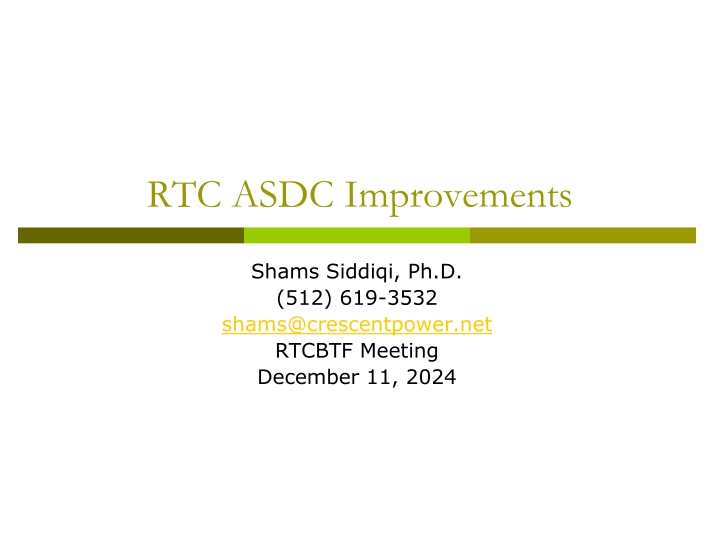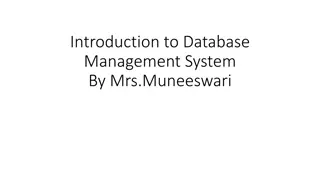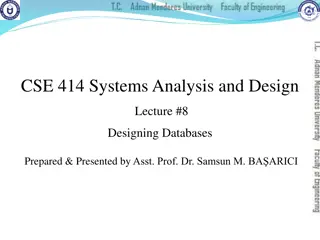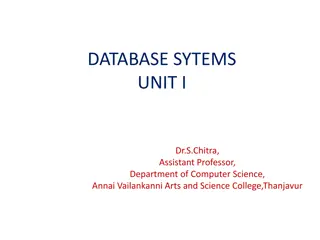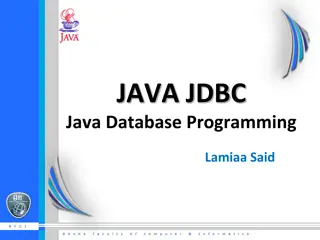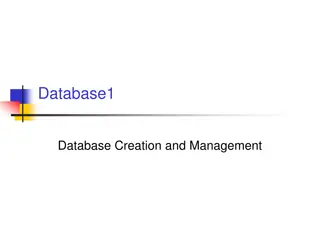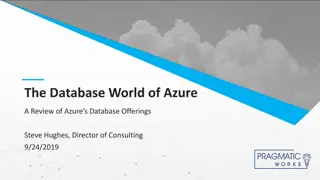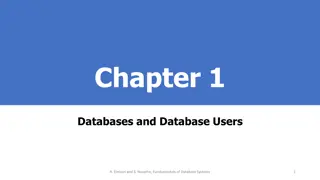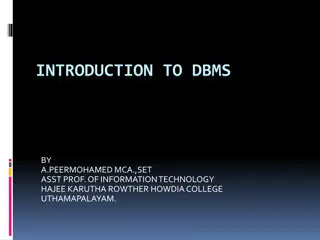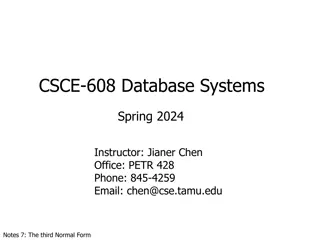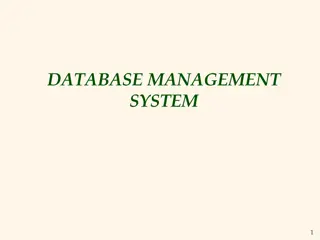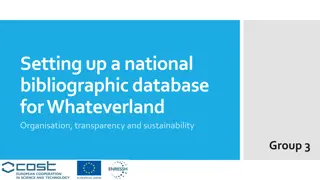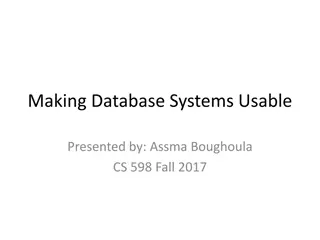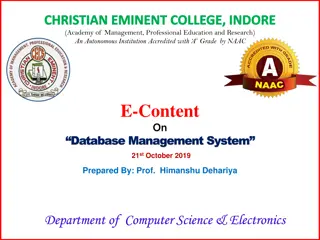Evolution of Database Systems
In the realm of data management, this presentation delves into the history, features, and structures of database systems, highlighting key milestones such as the introduction of structured query language, relational databases, and evolving data storage methods. It explores the significance of data organization, integrity, and security within the database realm, emphasizing the relational model and SQL language as cornerstones of modern database management.
Download Presentation

Please find below an Image/Link to download the presentation.
The content on the website is provided AS IS for your information and personal use only. It may not be sold, licensed, or shared on other websites without obtaining consent from the author.If you encounter any issues during the download, it is possible that the publisher has removed the file from their server.
You are allowed to download the files provided on this website for personal or commercial use, subject to the condition that they are used lawfully. All files are the property of their respective owners.
The content on the website is provided AS IS for your information and personal use only. It may not be sold, licensed, or shared on other websites without obtaining consent from the author.
E N D
Presentation Transcript
RTC ASDC Improvements Shams Siddiqi, Ph.D. (512) 619-3532 shams@crescentpower.net RTCBTF Meeting December 11, 2024
Background IMM ASDC Improvement IMM s ASDC improvements that use Blended ASDCs are greatly appreciated Fully agree with IMM recommendations: ASDCs could be better aligned with the marginal reliability benefit of each product ASDCs could be specified using a few parameters, rather than a complex derivation that starts with the AORDC ORDC design was based on the reliability benefit of Spinning Reserves1 (ECRS and Non-Spin in ERCOT) [i.e., dispatchable capacity to avoid VOLL] and not on value of essential frequency- responsive reserves (RRS and RegUp in ERCOT) to arrest frequency RRS & RegUp can be dispatched but they have much greater value in automatic frequency-triggered deployment to arrest frequency 1. Prof. Hogan references Shams N. Siddiqi and Martin L. Baughman, Reliability Differentiated Pricing of Spinning Reserve, IEEE Transactions on Power Systems, Vol. 10, No. 3, August 1995, pp.1211-1218 in his paper Reliability and Scarcity Pricing: Operating Reserve Demand Curves dated March 3, 2006. 2
Suggested Blended ASDC Improvements Note: ECRS and Non-Spin can be provided by NFRC-NCLR-CLR providing little reliability benefit within the SCED interval (but provide important price support for self-commitment and investment. Min performance risk/cost so RTC Offers likely to be very low) AS Plan RRS and RegUp are the critical minimum NERC-req. MW amounts required to timely arrest frequency and regulate within the SCED interval Sacrificing up to 500MW of RRS in favor of ECRS and Non-Spin during scarcity is a reliability risk that can be avoided Recommended Blended ASDC improvements are: Min RRS price: $1000/MWh. Assign 1 MW AORDC segments extending from start of curved AORDC out to RRS AS Plan amount. These segments form curved portion of RRS ASDC. Assign the remaining 1 MW segments of the AORDC first to ECRS and then Non-Spin alternately, until the AS Plan requirements for both products have been met. Assign any remaining 1 MW segments of the AORDC priced above $0.01/MWh to Non-Spin Finally, use linear interpolation to represent each ASDC with 100 price-quantity pairs Note: MCPCs and System Lambda would still be capped at $5,000/MWh with PBP at $11,053/MWh Higher ASDCs for RegUp and RRS to ensure their award since awards based on ASDC minus Offer 3
AORDC Changes to Reflect ASDCs ORDC was not used to procure AS but to set the ORDC adder to reflect the scarcity of Operating Reserves thus System Lambda was subtracted to ensure (System Lambda+ORDC Adder)<=SWCAP. However, AORDC used to actually procure AS should not be decreased by System Lambda as scarcity increases makes no sense. Thus, minus System Lambda used for setting ORDC price adder should not be applied to determine AORDC. Currently, offline ORDC Adder is just a mechanism to compensate offline resources (there is no such compensation under RTC only capacity actually awarded AS is compensated) but artificially suppresses the value of Reserves. Thus, to determine AODRC, eliminate accounting for offline capacity which suppresses the actual value of Ancillary Service reserves. ORDC is already the Operating Reserve Demand Curve and, thus, should be used to determine AS Demand Curves current tweaks were necessary since it wasn t being used as a Demand Curve but for setting a price adder AORDC formula should be exactly the unadulterated ORDC that ensures more reliable procurements of AS under RTC and avoids undervaluing AS: AORDC=(? CDF(??????? ?, ???, ????)) ???? if X>3000 or = ???? if X<=3000 where CDF=Cumulative Distribution Function of norm. distr. and X=MCL 4
Changes Ensure Critical AS during Scarcity During severe scarcity under RTC, SCED should award critical reliability RRS and Reg- Up instead of ECRS and Non-Spin but SCED may not under current RTC ASDC design: If remaining MWs have ECRS offer lower than RRS or Reg-Up Offer by even a penny and max ASDCs for both=$5,000/MW, then SCED will award ECRS and not RRS or Reg-Up Lessons learned from Uri: Grid must maintain enough Frequency Responsive Capability (RegUp and RRS) to prevent total collapse during frequency events even if it requires firm Load shed ASDCs for RegUp and RRS must be set high enough to ensure award Since ECRS and Non-Spin are likely to be offered near $0 and RegUp and RRS at near SWCAP due to opportunity costs and compliance risk during severe scarcity, SCED will award ECRS and Non-Spin instead of RegUp and RRS as long as $5050- $0 (ECRS offer) > $5100-$2000 (RRS offer). The way to ensure RRS is awarded is to set RRS ASDC=$5050+$2001=$7051 MCPCs and System Lambda (assuming no congestion) in both cases will be capped at $5,000/MWh so no impact on MCPCs or SPPs due to higher ASDCs (since ASDC MWs at or above $5000/MW do not exceed the MCL of 3,000MW) so, no price impact but critical reliability benefit Since all MCPCs are capped and System Lambda is capped at SWCAP proposed change ensures AS critical for reliability RRS and RegUp are given a higher priority in procurement during severe scarcity over of ECRS and Non-Spin MCPCs and SPPs during severe scarcity will remain the same with this change; however, critical AS would be procured 5
